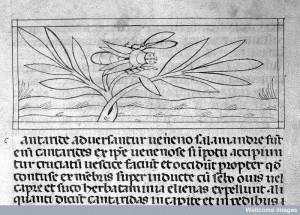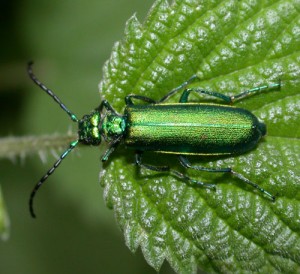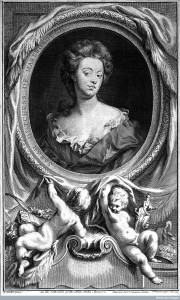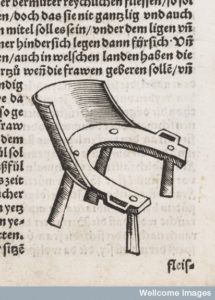 Spanish Fly, or Cantharides, are, as the name suggests, small emerald-green flies (above is a 13th century illustration of one). Crushed or powdered these flies were used throughout the early modern period as a medicinal substance. They were believed to be extremely irritating to the body causing heating and blistering, this could be beneficial and was recommended to treat certain disorders; but the use of Cantharides was always recommended with cautionary tales about the potential dangers of excessive blistering and burning they could cause. One such story explained to its readers,
Spanish Fly, or Cantharides, are, as the name suggests, small emerald-green flies (above is a 13th century illustration of one). Crushed or powdered these flies were used throughout the early modern period as a medicinal substance. They were believed to be extremely irritating to the body causing heating and blistering, this could be beneficial and was recommended to treat certain disorders; but the use of Cantharides was always recommended with cautionary tales about the potential dangers of excessive blistering and burning they could cause. One such story explained to its readers,
‘A certain Gentleman of the Town of Villeneuve, by the Lake of Geneva, having a cold Tumor in one of his Knees, caused by a cold, and tough Humor, did ask a Barbers advice, who without taking notice of the Antecedent Cause, went about to cure him only with Topical Remedies; therefore he applied first Cupping Glasses, after that a Cautery on the side of the Kneepan, thinking to empty the Matter that was gathered. When these did not succeed, he applied a Pultess made with Leaven and Cantharides,and did exulcerate all the Knee, then followed an excessive pain about the Knee, restlesness, a Feaver, and several other fearful Symptoms; among which, was a grievous pain of the Reins [the kidneys], and of all the Belly, and presently after such a heat in his Urine, that he could not make one drop (for it came only drop by drop, and that Bloody) without the greatest torture imaginable. The Pultess being removed, he was something the better’.1

Their extremely hot nature also meant that they were widely recognised as a very potent aphrodisiac. John Quincy claimed that ‘They certainly to a strange degree excite Lust, and provoke to Venereal Practices, not by any better Abilities which they give, but by stimulation those Parts which are the Seat or Incentives to such Desires.’2 Again though the dangers of consuming Spanish fly were highlighted. Jane Sharp in The Midwives Book complained that Cantharides could cause men to suffer from priapism (a continual and painful erection of the penis), and further lamented that ‘It is not to be imagined what pains some have undergone, who by indiscreet taking of Cantharides have fallen into this grievous distemper.’3
The dangerous and aphrodisiac nature of these small beetles was evidently well-known. They appeared in several trials at the Old Bailey where men and women had fed them to others and were being charged with murder and poisoning. One case in particular highlighted not only that they could be used to kill someone, but that all involved found it hard to completely disregard their supposedly titillating properties.
In January 1739 Catherine Demay appeared at the Old Bailey charged with murder. It was alleged that she had put ‘a great Quantity of Cantharides, being deadly Poison, into a certain Liquor, made of Coffee and Water boiled together’ which she had then given to Michael Dunn.4 Coffee as we have already seen had its own dubious reputation for affecting sexual ability and libido.
According to the testimonies of the witnesses in the case Catherine was a spinster lodging with Mr and Mrs Charlton, Michael Dunn was their journey man. Importantly those giving testimony in the case felt that it was necessary to highlight that Catherine had not been motivated by the thought of seduction or causing Michael to lust after her, but instead by a ‘Malice’ that spurred her to ‘kill and murder’ him.5 Mrs Charlton even told the court that ‘I never saw any Familiarity between them’ and Mr Charlton confirmed that ‘I know nothing of her Condition, nor of any Intimacy between her and the Deceased.’6
Even though lust was ruled out as a motive, Cantharides were not seen simply as a poison. Their aphrodisiac effects were still invoked: Having drunk the coffee Catherine provided, Michael Dunn began to feel unwell, and on the Sunday afternoon he took a walk to his brother’s house. When his brother found him sitting on an alehouse bench Michael’s condition had deteriorated, he took him home put him to bed and gave him some medicines. Despite these ministrations Michael called out ‘Brother! Brother! help me up, of else I shall die in the Bed.’7 An apothecary, Mr Varney, was called in who immediately suspected that Michael might be suffering from a venereal disease and asked him ‘if he had not been meddling with Girls, and desired him not to be afraid to tell us, if it was so.’8 The testimonies then further alluded to the stimulating effects of this particular medicine by stating that about three hours after he had drunk the coffee
‘he found a very strange Alteration in himself, -(The Witness here made Use of such Expressions, in his Account of the Disorder, and the Effects of the Poison, as Decency obliges us to suppress.)’9
Several medical witnesses were asked whether or not Michael had in fact caught a venereal disease by lying with unclean women, they all responded that he had sworn to have never been with a woman. They were also asked whether or not he had been taking cantharides in order to cure the venereal disease, and so had suffered from a medical overdose rather than deliberate poisoning. At this point in the case report the testimonies become fascinating, creating a medical discussion that tried to disentangle the effects cantharides would have upon the body and the length of time needed for these to become visible.
Mr Varney, the original apothecary called in to aid Michael Dunn, reported to the court that when he had arrived the patient’s stomach was greatly disordered, he had an uneasiness in his throat and a violent strangury (inability to urinate). When asked what could have caused him to die in this way he concluded:
‘I think nothing could produce such Circumstances, or be the Occasion of it, but Cantharides. Such Symptoms are likely to ensue, on a Person’s taking a Dose of them, and on that only, in my Opinion. Cantharidestaken in an undue Quantity; are-Poison. I have been an Apothecary twenty two Years, and am acquainted with the Operation of Cantharides.’ 10
He was further questioned about whether it was usual for cantharides to be used to cure some stages of the ‘French Disease’, to which he said yes, and how long after consuming Spanish flies the effects would be noticeable, to which he answered twelve hours.
Mr Tagg, a surgeon who had also attended Michael, was asked similar questions and concluded that ‘The Symptoms the Witnesses have described, are the Effect of Cantharides; and if they are improperly given, they are absolutely Poison’, ‘There were no Symptoms of the Foul Disease; if there had, I must have seen them. I take it, that nothing but taking an Over-dose of Cantharides was the Cause of his Death’. Mr Tagg concurred with the apothecary that the effects of cantharides would be seen within 12 hours, although he also noted that if applied externally to the body a person may be able to continue for a few days without feeling the effects. 11
A Dr Connel further corroborated this story stating that he was convinced the patient was suffering from the effects of cantharides, and that the patient may well have continued some time after his poisoning without symptoms, ‘According to the Temperament of the Stomach, and the Quantity taken, he might go about a Week. I have administer’d Cantharides, and have been acquainted with the Medicine fifteen Years: I think a Man may go on eight Days before he comes to such a Condition.’ 12
Witnesses in support of Catherine attested to her good character, pointed out that she had not had the opportunity (being alone with the coffee) to add the small flies to it and that they had seen that Michael had medicines in his possession for curing the pox: John Thompson told the court ‘That about a Month or five Weeks before the 15th of December, he saw a Box of Pills and a Phial in the Deceased’s Possession, which he told him was to cure a young Man of the aforesaid Malady’. Similarly James Gilstrop stated that ‘I took a Walk with the Deceased, and as we were going along, he said, – G – d, Doctor, I have got the foul Distemper, and shew’d me a Box of Pills; telling me, they were to cure him … He told me his Case, and shew’d me the Pills out of Fun, and in a bragging Way.’ 13
Although the medical practitioners agreed that Michael had probably died from excessive consumption of Cantharides, there was clearly enough doubt about how they had come by them to acquit Catherine of the murder and she was found not guilty. Sexual activity, and sexual disease, were central to this case of suspected murder and so was the small Spanish Fly whose reputation as a strong medical substance, terrible poison and potent aphrodisiac. Untangling the reason why Michael had ingested the bugs and for what reason thus became the core of understanding whether Catherine was a dangerous murderess or whether Michael was a lascivious fellow dying as a result of his own debaucheries.
_________________________
1. Theophilus Garencieres,The admirable virtues, and wonderful effects of the true and genuine tincture of coral, in physick; grounded upon reason, established by experience, and confirmed by authentical authors in all ages ... (London, 1676),p. 55
2. John Quincy, Pharmacopœia Officinalis & Extemporanea: or, a Compleat English Dispensatory, in four parts… the fourth edition (London, 1726), p. 174.
3. Mrs Jane Sharp, The Midwives Book. Or, The Whole Art of Midwifery Discovered … (London, 1671), p. 31.
4.Old Bailey Proceedings Online (www.oldbaileyonline.org, version 7.0, 09 July 2013), January 1739, trial of Catherine Demay (t17390117-7). http://www.oldbaileyonline.org/browse.jsp?id=t17390117-7&div=t17390117-7&terms=cantharides#highlight
5. Ibid
6. Ibid
7. Ibid
8. Ibid.
9. Ibid
10. Ibid
11. Ibid
12.Ibid
13.Ibid
© Copyright Jennifer Evans, all rights reserved.




“The deposition then further alluded”
This is not a series of depositions, taken before a magistrate or the coroner. This is sworn testimony in open court, before the petty jury, and recorded by the writer of the news report.
Do the depositions from the inquest survive? They may tell a different story. However, Thomas Forbes reported finding none for 1738 or 1739, in this article, but he wrote quite a few.
http://www.ncbi.nlm.nih.gov/pmc/articles/PMC2595405/?page=1
The different lengths of time offered by medical witnesses, for the operation of the poison, are interesting.
There is testimony that he had tried to buy Elixir Antivenereum locally, but there was no cantharides in that preparation. Who bought the cantharides, and from whom? Did the barber also treat venereal diseases? Did the barber use cantharides for the treatment of baldness?
Why did he die in St. Margaret’s Westminster? Was he removed there by his employer, his family, or the parish?
“her Business was making Habits, and Manteels, and had some little Income beside” — Do we know anything else about her? Was she a Huguenot, for example? Is she in the [unprinted?] parish register? Did she leave a will?
I really thought the medical testimonies were very interesting, but wasn’t sure whether including them would make the blog post far too long for people to read. I was fascinated by the idea of time in the case – not just whether he had caught a venereal disease but how long it took for drugs to cause symptoms and side effects.
I really just stumbled across the case and trial records are not my usual source base so I have not followed any of this up yet. Thank you for the link.
I did once write about legal medicine in this period, but I’m no expert.
The London assizes are unusual in having a series of news pamphlets, and plenty of “last words” published by the prison chaplains, and it’s not too hard to track down the medical practitioners.
That is great to know thank you, there are such interesting cases on the Old Bailey website its great to have access to them all.
The thing about common law courts is that there was no requirement to record the evidence, as appeals could only be lodged on matters of procedure. The jury was the only judge of fact. So, it doesn’t matter how many depositions, indictments, and assize rolls we have, we can’t know what was said during the trial. In the provinces, where the assizes came round twice a year, there was plenty of opportunity for the defendant’s friends to “improve” the evidence. A case that looks cut and dried in the coroner’s records might well end up with an acquittal.
It is widely believed that we know what evidence was given in the Salem witch trials. The only account of the trials is a short narrative of some trials by Cotton Mather, who wasn’t present. What we do have is pre-trial depositions and investigations by the magistrates.
The surviving records of other court systems, in England and elsewhere, are more useful for the ethnographic historian.